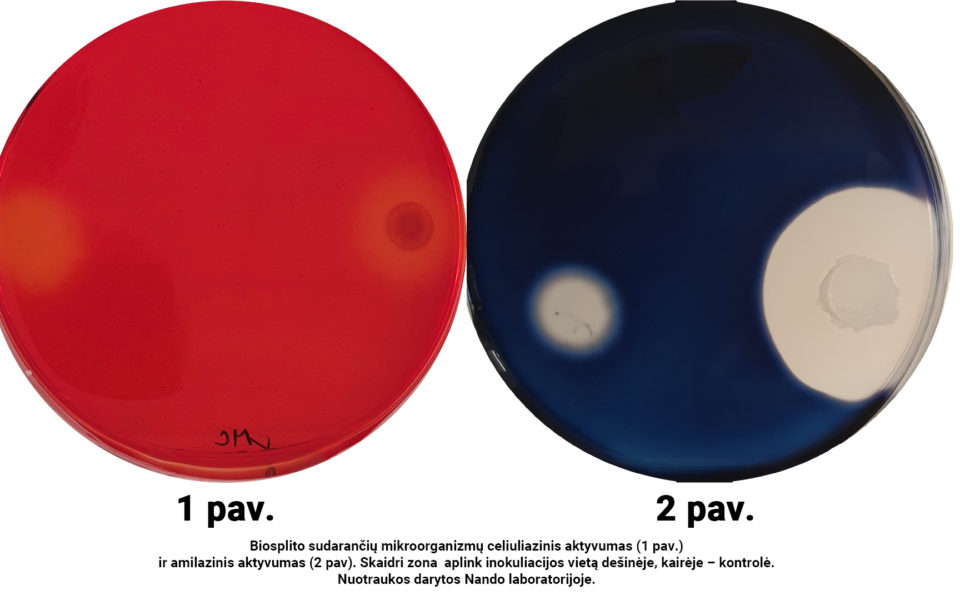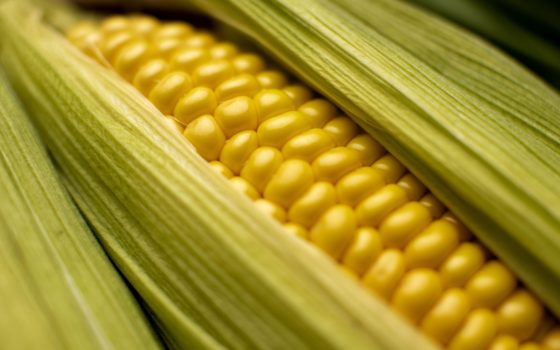Intensive crop farming is dominated by short-rotation crops such as rapeseed and cereal grasses, occupying ever larger areas. Meanwhile, permanent grassland and pastures are drastically decreasing in area. In these farms, many field residues remain, including straw (6-10 tonnes/hectare), which has recently become the main organic fertiliser that adds nutrients to the soil.
Straw decomposition processes
Straw is usually high in fibre and low in protein and starch. Lignocellulose is the most abundant component of plant biomass, consisting of cellulose and hemicellulose polysaccharides and a complex aromatic polymer, lignin. Lignin is the most mechanically recalcitrant, chemically inert and indigestible biomass material, which, integrated into the cellulose and hemicellulose molecules, seemingly glues them together, further complicating their decomposition. Only a small portion of soil fungi are able to completely decompose lignin into CO2.
Soil micro-organisms, which intensively transform biomass into nutrients available to plants, play a key role in the straw decomposition process by humifying part of the organic matter and thus contributing at least partially to maintaining the humus balance in the soil. The processes of straw mineralisation and humification in the soil are determined by the chemical composition of the straw, the type and moisture of the soil, and the technological solutions applied.
The carbon-to-nitrogen (C/N) ratio is one of the main indicators for the decomposition of organic matter. The most effective process for decomposition of field residues occurs at a C/N ratio of not more than 35:1; in that case, the soil microorganisms get enough carbon for energy and nitrogen for protein synthesis. The straw of cereal grass crops contains carbon-rich organic compounds with a wide range of C/N ratios (45:1-110:1), and for this reason decomposition of the straw occurs slowly. In order to break down such straw, microorganisms must compensate for the nitrogen deficiency and take it from the soil, so it is recommended at the beginning of the vegetation period to apply nitrogen fertilisers to winter crops planted in stubble, so that the plants do not lack nitrogen. In summer crop rotation, there is no need for additional nitrogen to decompose the straw remaining after winter, as the plants use nitrogen from already-mineralised straw.
The optimum soil moisture for straw mineralisation is 40-60 %. If the moisture is less than 40 %, the activity of microorganisms decreases. If the moisture is more than 60 %, the nutrients are washed away, the oxygen content is reduced and anaerobic conditions unfavourable to decomposition occur, in which the straw could be said to be preserved, it becomes mouldy, and greenhouse gases (GHG) and toxic by-products are released.
Recommendations for straw
Straw is recommended to be shredded or chopped immediately after harvest, evenly spread and worked into the shallow top layer; such close contact between field residues and the soil ensures the proper moisture regime, aeration and good access for micro-organisms to intensively digest the field residues. Additional challenges arise in cases where the amount of straw remaining is so large that it is not possible to spread and work it evenly into the soil and as a result some of it remains on the surface of the soil. In this case, microbiological products helping to accelerate the mineralisation of straw are the best solution.
How to accelerate straw decomposition?
Nando produces BioSplito, a biological product enriched with enzymes, bacteria and microscopic fungi, which promotes straw decomposition, mineralisation of organic matter, and disruption of viable pathogens wintering in the remains of diseased plants.
The enzymes in the product immediately start the decomposition of field residues, and their work is continued by micro-organisms and their secreted enzymes. Endoglucanase, exoglucanase and β-glycosidase break down cellulose (Figure 1) and xylanase, esterase and other enzymes break down hemicellulose into D-glucose and other common sugars that are readily absorbed as a source of carbon and energy. Laccases and peroxidases, synthesised by microscopic fungi, carry out the decomposition of recalcitrant lignin, thus clearing the way for faster breakdown of cellulose and hemicellulose. Amylase hydrolyses starch (Figure 2), which is absorbed by microorganisms as an easy source of energy, and chitinases break down chitin, the main component of the cell walls of fungal pathogens.
It is recommended to spray the BioSplito product in the autumn on straw not worked into the soil or on straw shallowly worked into the soil immediately after harvesting, and in spring on the remaining undecomposed straw after the planted crop germinates.

